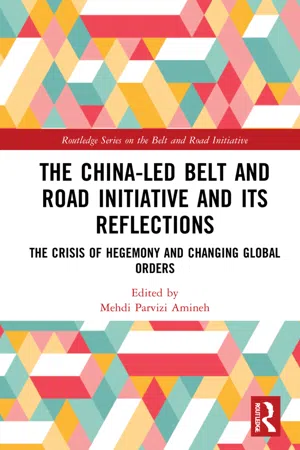
The China-led Belt and Road Initiative and its Reflections
The Crisis of Hegemony and Changing Global Orders
Mehdi Parvizi Amineh, Mehdi Parvizi Amineh
- 296 pagine
- English
- ePUB (disponibile sull'app)
- Disponibile su iOS e Android
The China-led Belt and Road Initiative and its Reflections
The Crisis of Hegemony and Changing Global Orders
Mehdi Parvizi Amineh, Mehdi Parvizi Amineh
Informazioni sul libro
This book analyzes the origins and the impacts of China's Belt and Road Initiative (BRI) on diplomacy, economy (trade, investment, finance), and security among selected host countries and regions in Asia, Africa, and the European Union.
By examining the geopolitical economy of BRI activities, it concisely describes the impact of the rise of China and its BRI policy strategy on the reshaping of world order and global governance. This volume explores the BRI by addressing several key questions including:
• Why did the Chinese leadership set up the BRI?
• What are the activities of BRI projects in the participating countries and related regions?
• What are the challenges to the successful implementation of the BRI in the various countries and regions?
Moreover, through its analysis of the abovementioned questions, it provides novel contributions to the ongoing scholarly debates between Chinese and non-Chinese scholars – among others, the debate surrounding the "rise of China" and its impact on global governance.
Featuring an extensive variety of expert contributors, this study will be an essential reading for students and scholars of International Relations and Global Political Economy as well as Chinese politics and those with an interest in the Belt and Road Initiative more broadly.
Domande frequenti
Informazioni
1 China’s capitalist industrial development and the emergence of the Belt and Road Initiative
List of Abbreviations
AEI | American Enterprise Institute |
AIIB | Asian Infrastructure Investment Bank |
BRI | Belt and Road Initiative |
BRICS | Brazil, Russia, India, China, and South Africa |
CDB | China Development Bank |
CEEC | China Energy Engineering Corporation |
CNOOC | China National Offshore Oil Corporation |
CNPC | China National Petroleum Corporation |
CRCC | China Railway Construction Corporation |
CSCEC | China State Construction Engineering Corporation |
CSMC | Centralized state-society market complex |
EOI | Export-oriented industrialization |
FDI | Foreign direct investment |
GDP | Gross domestic product |
GPE | Global Political Economy |
IEA | International Energy Agency |
IMF | International Monetary Fund |
IR | International Relations |
ISI | Import substitution industrialization |
LSMC | Liberal state-society market complex |
MNC | Multinational corporation |
NDRC | National Development and Reform Commission |
NOC | National oil company |
OECD | Organization for Economic Cooperation and Development |
PPP | Purchasing power parity |
SAFE | State Administration of Foreign Exchange |
SCO | Shanghai Cooperation Organization |
Sinomach | China National Machinery Industry Corporation |
SOE | State-owned enterprise |
SRF | Silk Road Fund |
US | United States |
Introduction
Critical evaluation of the scholarly literature on BRI
- Why did the Chinese leadership set up the BRI?
- What are the impacts and challenges of the BRI on the participating countries and regions and the global political economy and its governance?
Indice dei contenuti
- Cover
- Half-Title
- Series
- Title
- Copyright
- Dedication
- Contents
- List of Figures
- List of Tables
- List of Maps
- List of the Contributors
- Acknowledgements
- Introduction: The China-led Belt and Road Initiative and its reflections
- 1 China’s capitalist industrial development and the emergence of the Belt and Road Initiative
- 2 China’s rise and the question of hegemony and world order
- 3 Supply-side perspectives from China: Structural industrial change and industry incentives for participating in the Belt and Road Initiative
- 4 Ethiopia and the Belt and Road Initiative: The impact of Chinese investments on the industrialization of Ethiopia
- 5 Western Balkans: How to coordinate the Belt and Road Initiative with the EU’s Enlargement Policy
- 6 An assessment of the Hungarian partnership in the Chinese Belt and Road Initiative
- 7 Geopolitics of change: China, the Belt and Road Initiative, and Asian regions
- 8 BRI in the Middle East and Central Asia: The case of Kazakhstan, Iran, and Turkey
- 9 Strategic alliance or cooperation of convenience: Iran’s linking the Chinese and Russian transit routes to connect Asia to Europe
- 10 Facts on China’s outward energy investment in Belt and Road countries
- 11 The Belt and Road, global governance, and China
- Index